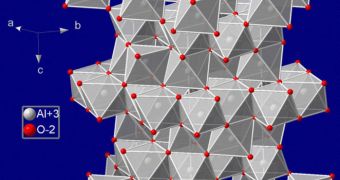An international physics team announces the development of a research method that allows for the controlling of key electrical, chemical and magnetic properties in crystals such as sapphire.
The procedure is also capable of exerting control over the material's durability and strength, the team says, adding that the changes occur when the crystal is deformed at very high temperatures.
A perfect sapphire crystal is made up of regular columns of aluminum and oxygen atoms, which are bound together in a very specific configuration – each aluminum atom is surrounded by six oxygen atoms.
When the material is subjected to high temperatures, observable deviations called atomic dislocations take place, which rearrange the crystalline structure. As such, some aluminum atoms are now surrounded by only four oxygen atoms.
The new investigation was conducted by researchers at the Case Western Reserve University (CWRU), in the United States and the Institute of Solid State Research, in Jülich. Germany. Details of the work appear in the November 26 issue of the top journal Science.
An electron microscope was used to determine whether applying high temperatures to sapphires changes their internal structure. The group showed that this can happen, and that indeed it does.
Though losing two of six oxygen atoms may seem inconsequential, the changes have a profound impact on the behavior and traits of the resulting crystals, Science Blog reports.
What is interesting to note here is that the methodologies, information and imaging methods that were used for the new study can be applied to a wide array of crystalline solids.
These materials can be found in a wide range of devices and tools, used from producing microchips to devising thermal protection systems that protect jet engines from extreme heat caused by combustion.
“We imagined this might have been the possible change in structure a year or so ago and now we’re able to see how the atoms are moving with respect to one another,” explains expert Arthur Heuer.
He holds joint appointments as the Distinguished University Professor and the Kyocera Professor of Ceramics in the CWRU School of Engineering Department of Materials Science and Engineering.
“The important thing is we were able to image it with atomic resolution,” he goes on to say. “Understanding the structure of the dislocations is important because it allows increased understanding of material properties,” adds Peter Lagerlöf.
He holds an appointment as an associate professor of materials science and engineering at CWRU. The expert says that the new study could be used to underlie the next generation of advanced computer chips.

 14 DAY TRIAL //
14 DAY TRIAL //